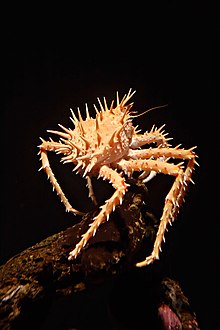| Paralithodes californiensis | |
|---|---|
 | |
| Rear view of Paralithodes californiensis | |
| Scientific classification | |
| Domain: | Eukaryota |
| Kingdom: | Animalia |
| Phylum: | Arthropoda |
| Class: | Malacostraca |
| Order: | Decapoda |
| Suborder: | Pleocyemata |
| Infraorder: | Anomura |
| Family: | Lithodidae |
| Genus: | Paralithodes |
| Species: | P. californiensis |
| Binomial name | |
| Paralithodes californiensis (Benedict, 1895) | |
Paralithodes californiensis, also known as the spiny king crab and the California king crab, is a species of king crab [1] [2] [3] It is closely related to P. rathbuni with the same common names being used for the two and some authorities suggest that they might be conspecific. [4] P. californiensis is found on muddy or rocky bottoms at depths of 145–300 m (476–984 ft) in the Pacific Ocean off southern California (Pismo Beach to San Diego). [4]
